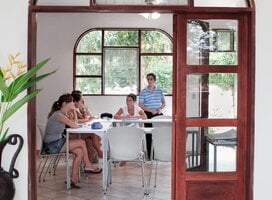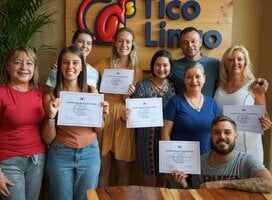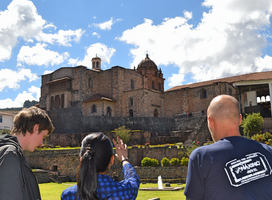Spanish Language Schools
With more than 450 million native speakers worldwide, Spanish is the world’s second most widely spoken language and the primary language in the Western Hemisphere overall. It is the first language in 20 countries and Puerto Rico, and a significant second language in several other nations, including Belize, the Philippines, and the United States, where more than 43 million people are Spanish speakers.
Whether you’re embarrassed that you constantly mispronounce “quesadillas,” want to really understand the lyrics to Shakira’s older (better) songs, or just need to get out of your monolingual shell, there’s never been a better time to learn Spanish. The best part is that there’s likely to be a community of Spanish speakers, possibly even from your country of study, living in your hometown, so you can extend your practice long after you come home!
The presence of Spanish throughout essentially all of Latin America makes it a stunningly diverse language. This means your choice of where you decide to learn Spanish will have a significant influence on how you learn to speak, the accent you develop, vocabulary you acquire – and even what other people think of you. News flash: not all Spanish-speaking nations are born alike, and they don’t even all like one another. And you thought this was going to be simple!
The culture of the Spanish-speaking world has so many amazing aspects to discover, from food and drink in Spain to music in Mexico to dance in Argentina. Immersion- or even culture-based programs can be a perfect way to tap into this – what better way to learn the language of romance than through a salsa or tango class?
Due to the high demand for and relative ease of the language, there are nearly endless options and different types of programs to learn Spanish abroad. Part of this is because of the number of different countries where Spanish is spoken, allowing for greater diversity in locations, homestay options, type of program or institution and academic calendar.
Because Latin American countries are closer to home than Europe or Asia for many students, particularly those coming from the U.S., there are also more short-term options, as flights and other expenses aren’t as high as they are for students going farther afield to regions like the Middle East or Asia.
Study abroad semesters, or joint study/cultural immersion programs, especially ones that include a homestay element, are some of the most popular options for language students. The number of high-quality universities throughout Spain and Latin America also mean that regular university courses can be a good option, and there are many language institutes throughout the region that offer short, intensive courses that are especially popular with backpackers and other travelers. Volunteering can also be an excellent way to learn Spanish, as you’ll be interacting with native speakers on a daily basis and there are hundreds of NGOs throughout Latin America that are always happy to accept volunteers.
University Courses
Many universities in large cities offer multiple kinds of language courses – some may be more oriented toward grammar or writing skills, while others may be designed specifically for non-native speakers. These types of programs can vary in length from about 6 weeks to up to a semester – shorter classes are usually more intensive, with an almost-daily schedule.
University courses are a great way to meet other students, get involved directly with a local institution, and learn from native teachers, plus they’re often very affordable, especially public universities. However, they also require a certain degree of independence, as there’s often little oversight and you might only have one final paper for your entire grade, so be prepared to take responsibility for knowing what the homework is, or asking someone who does.
Homestay Programs
Programs with homestays like Na'atik Language and Culture Institute place students in a living situation (an apartment or house) with a local family, giving the student a chance to learn customs and colloquial vocabulary and practice the language in a daily context, as well as interacting with native speakers. Homestays often complement other types of study, like university courses or volunteering, so they typically last for the duration of the course.
Though living in someone else’s home can be challenging, the language, social and cultural benefits of participating in a homestay are unparalleled – for many students, it’s how they really begin to feel comfortable speaking a new language. If you’re extremely independent and can’t stand the idea of following a curfew or having someone else cook for you, a homestay may not be for you, but if you’re willing to be flexible, it can be the best part of learning Spanish!
Language Study & Culture Immersion Combination Programs
Balancing study and life is important, especially when it comes to learning a language. Many study abroad programs like EF and Maximo Nivel recognize that students aren’t only there to go to class, and incorporate elements of cultural immersion into the program, whether through group outings to events, special culture-focused classes or offering students the chance to participate in activities, internships or other spaces that facilitate cultural exchange throughout the semester. Mixed language and cultural immersion programs are ideal for students that want language learning to extend outside the classroom and seek opportunities to use the language in a real context, as well as learn more about the country in which they live.
Language Study & Volunteer Combination Programs
Like the cultural immersion combination programs, volunteer combination programs are for students who want to complement language study within a non-academic context. There are thousands of nonprofits and other organizations across Latin America and Spain that welcome volunteers in field as diverse as education, health care, and conservation – you’re sure to pick up some specialized vocabulary while you’re there!
Language study and volunteer combination programs can be as short as a few weeks or as long as a year, so they’re ideal for people with more restricted schedules who can’t take a whole semester, or for those students who want to get more involved in a community while learning the difference between ser and estar.
Did you know...? Many Spanish speakers in South America actually prefer to refer to the language they speak as castellano (Castilian) rather than español (Spanish), due to its origin in the Castile region. Central Americans, Uruguayans and Colombians typically call their language español, and Spain uses both.
From Cataluña to Patagonia, there are countless places to study Spanish! It is the primary language in every continental country from Mexico south, with the exception of Belize, French Guiana, Guyana, and Suriname – as well as Cuba, the Dominican Republic, Equatorial Guinea and, of course, Spain.
The geographic range of countries means there’s something for just about everyone, whether you want beaches or mountains, massive cities or tiny rural towns, a place with a strong indigenous culture, a particular style of music, cheap wine or consistent access to Wi-Fi.
Keep in mind, though, that accents and cultural norms also vary widely across this spectrum of countries, from European Spain to European-wannabe Argentina, and everywhere in between.
-
Spain: For the traditionalists, there’s no better place to learn than Spain. With dozens of programs in major cities like Madrid, Barcelona, and Sevilla, Spain is one of the top destinations for prospective Spanish speakers.
One thing to keep in mind is that the Spanish spoken in Spain is very different, in terms of accent and grammar than the Spanish spoken throughout most of Latin America, so if you’re hoping to use Spanish as a job skill later on, be aware that you may have to adjust to another style.
-
South America: Back on the other side of the Atlantic, both Chile and Argentina are perennial favorites for hopeful hispanohablantes, with thousands of English-speaking students studying in these countries each semester. Both countries have a wealth of stunning natural landscapes, modern cities, and culture, as well as a cornucopia of different language learning options, from studying in one of the highly-ranked universities in cities like Buenos Aires, Córdoba, Santiago or Valparaiso to programs linking public health and traditional medicine. However, both countries also speak some of the most distinctive and accented Spanish in Latin America (Argentina even uses different second-person pronouns!), so if you study in one of these countries, you’re likely to come away speaking like a chileno or porteño, and people will notice the difference. For many, though, this is a small price to pay for the delicious and affordable wine, great nightlife and outdoor exploration these two countries have to offer.
-
Central America: Things are a bit more casual up in Central America, with fewer formal university programs but plenty of language institutes and other volunteering and homestay opportunities. Two of the most popular Central American locations for Spanish students are Costa Rica and Guatemala, which have both built solid industries catering to short- and long-term language students alike.
Charming Costa Rica is a vacation dreamland, with beaches, volcanoes and rainforest all within a few hours’ drive from the less-scenic capital. Costa Ricans, or Ticos, also speak some of the clearest Spanish in Central America, and what better place to learn than from some of the continent’s happiest and most laid-back people?
Guatemala, particularly in the city of Antigua, is home to a number of professional, long-standing language institutes that offer high-quality classes for short- and long-term students – and it doesn’t hurt that this beautiful colonial city is in the midst of the country’s volcanic peaks and sweeping landscape.
With so many great locations, it can be hard to choose a great Spanish language course abroad! Still, there are other important factors to consider when choosing a Spanish program, including the cost of the program as well as the cost of living, any academic or language requirements and what you may want to do with your free time.
Why Learn Spanish Abroad?
With geographic, linguistic, and cultural diversity to spare throughout the 20+ countries where it is spoken, Spanish is one of the most variable languages in the world. It isn’t just the language itself that’s open to variation, though – the number of different types of programs means there’s something out there for every prospective Spanish learner, whether they’re a confident speaker or a newbie, city or country mouse, a salsa pro or a dancehall wallflower.
Requirements for programs will vary considerably depending on the length of the program and the host organization. Generally, a good rule of thumb is to assume that university and formal study abroad programs will have the strictest or most extensive requirements, while volunteer organizations and language institutes will require less.
Almost all programs will ask for some kind of application – this could be as simple as a letter of interest or as complicated as sending essay questions, transcripts, health insurance information and other required paperwork. Most programs are open to students over age 18; although there are programs specifically for high school students and those under 18. These will almost always require parental permission, and some volunteer organizations will only accept volunteers over 18 (or the local working age).
As a language student, your host organization will understand that you are not entirely fluent, but you may be asked to prove a certain level of proficiency or show that you’ve taken some prior Spanish courses, especially if you’re going to be working, volunteering or studying in a university where courses are taught in Spanish.
If you are enrolling directly in a university or through your home institution, or in any other program you intend to submit for class credit, you will likely have to prove student status and/or show proof of enrollment. If you are in a non-credit, certificate or volunteer program, this may not be necessary. Depending on the type of program, length of your stay and country you’re in, you may need to get a visa – most programs will offer guidance on how to do so and might even sponsor your visa, but they won’t always do the process for you, so be prepared to go through some paperwork and pony up the fee.
Level of Difficulty
Spanish is overall a relatively easy language to learn, especially if you’ve already been exposed to it. For casual learners, a volunteering gig that offers lessons on the side may be a great option, while more serious Spanish students may want to opt for university courses or an intensive language program. Beginners should definitely start with a structured class, as it’s important to learn grammar and verbs before setting off to figure out everything else on your own – more advanced students may want to skip straight to registering at the university or diving into a long-term volunteering assignment in a remote town.
All Spanish learners should be mindful of working on their vowel pronunciation: each vowel only has one sound, which makes Spanish pronunciation much easier than English, but those sounds are different from those in English, and the vowels are often where the dreaded “gringo accent” is the most noticeable. There is a veritable mountain of excellent Spanish-language media out there, from movies to TV shows to music to Nobel-prize-winning novels, so try to find something you like and use that as an extra study tool.
Financial costs are a major concern for just about anyone going abroad, and Spanish language programs run the gamut from fairly inexpensive to quite costly. Short-term programs are typically cheaper than semester- or year-long ones, but remember to factor in flights, visa fees, vaccinations and other expenses when making a budget.
For students on a budget, the best places are Central American countries like Guatemala or Nicaragua, or smaller South American nations like Ecuador and Bolivia. Argentina, Chile and Spain are quite expensive, and tourist-friendly spots like Costa Rica and Panama also have a higher cost of living.
If you have your heart set on one of the pricier countries, one option is to look farther afield – smaller towns are guaranteed to be cheaper than the major cities, where the cost of living is the highest. It’s wise to follow the same kinds of saving strategies – limiting the number of times you eat out at restaurants, taking public transit or biking rather than taxis, etc. – as you would at home. If your program and visa allow it, you can also look for part-time work while there – there’s always high demand for private English classes, if that’s something that appeals to you.
Scholarships
- The American Institute for Foreign Study (AIFS) offers multiple diversity and need-based scholarships in amounts up to $1,000 per semester for students abroad.
- Boren Scholarships: (up to $20,000) are available for students who intend to study in Latin America or the Caribbean for at least one semester, particularly those focused on development or national security issues. Applicants must demonstrate a desire to seek work in the federal government following graduation.
- CIEE's scholarships provides funding for study abroad students, including those pursuing intensive language study through a CIEE program
Spanish Language Programs Abroad
Pagination
What People Are Saying
Related Language Schools Articles
Frequently Asked Questions
-
Where can I learn Spanish abroad?
There are over 20 countries where the official language is Spanish. Some of the most popular places to study Spanish abroad include Spain, Chile, Argentina, Colombia, Mexico, Costa Rica, Guatemala, and Cuba.
-
What is the best way to learn Spanish?
The best way to learn a language depends on your learning style. However, immersing yourself in a Spanish language program with weekly courses, participating in cultural activities, living in a homestay away from other international students, and practicing independently can all be very effective ways to learn Spanish.
















